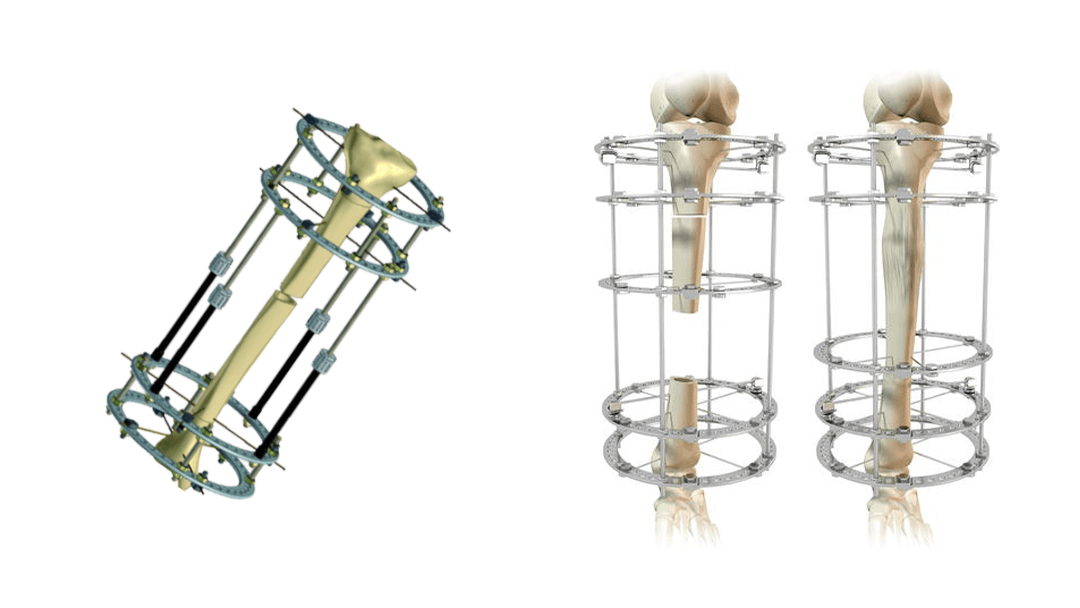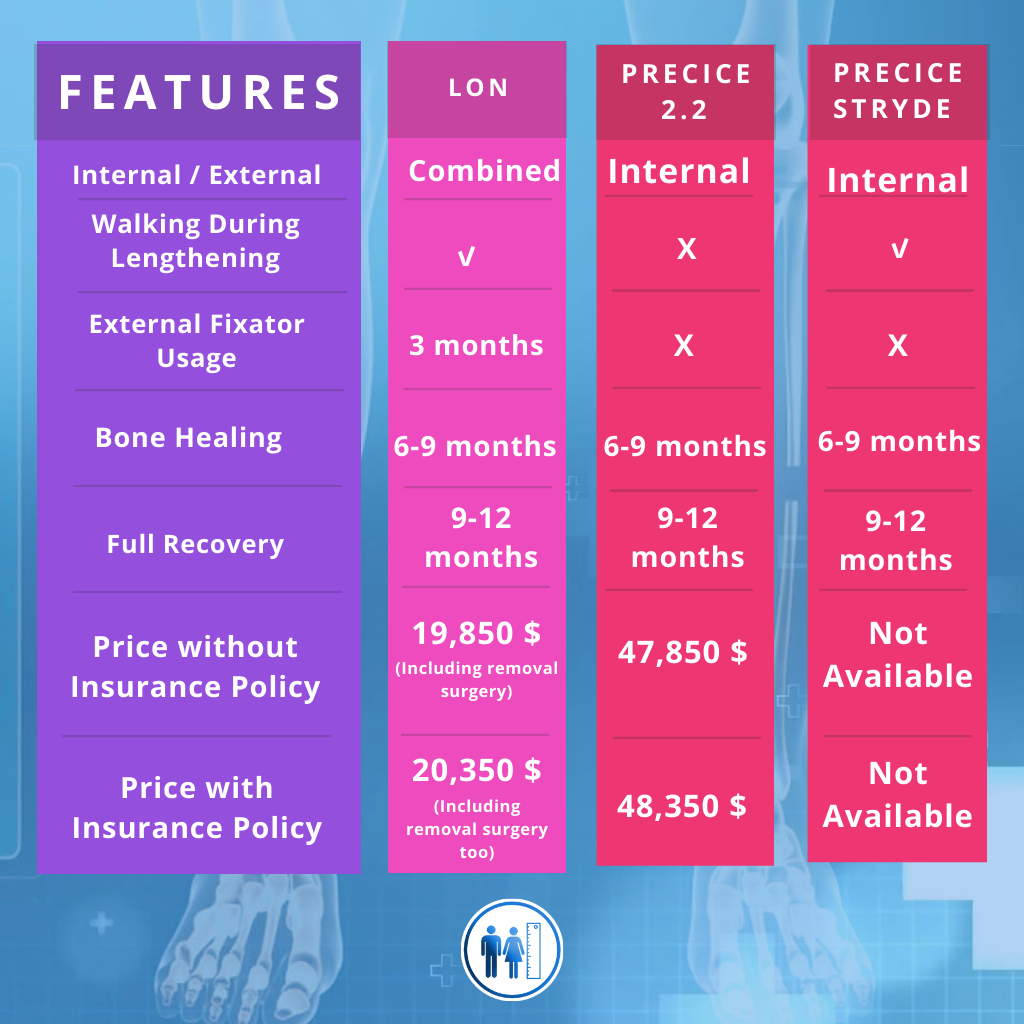Limb lengthening surgery encompasses medical process that has gained significant interest in recent years. It presents an option for those unpleased with their stature (for cosmetic reasons) or those with limb irregularities due to birth conditions, trauma, or other medical causes. In this detailed overview, we’ll give explanation about the process of lengthening surgery, examining its objectives, methods, pros and cons, and the care required before and after the procedure.
Evolution of Limb Lenghtening Surgery

Some countries such as Kurgan and Russia have been performing lenghtening surgery for almost 50 years.
Especially when we look at the years 1980-90s, a faster and more comfortable healing process began to be experienced with the developments in the techniques and devices used during this surgery. This situation caused the popularity of the surgery to increase.
While at first lenghtening surgery was performed due to medical conditions, after the 2000s, it began to be preferred for aesthetic reasons. The biggest reason for this was that confidence in this surgery began to increase.
Cosmetic Limb Lenghtening Surgery
Cosmetic height surgery is a procedure in which the major bones of legs (either femur or tibia) are cut surgically, and then metal fixators are attached to the legs. Using these devices, typically, bones are lengthened by 1 mm each day. Using this method, one can achieve a height increase of up to 7-8 cm for the femurs or 6-7 cm for the tibia. These represent the utmost increments in a single operation, ensuring no lasting soft tissue harm or impediments in walking or sports activities. In terms of imperial measurements, this equates to an approximate gain of 2-3 inches in a single session.
For those targeting a height increase of 10-15 cm (4-6 inches), two surgeries can be considered, spaced at least 6 months apart. This interval ensures the patient’s bones have properly fused and they can bear their full weight before the next procedure. Yet, it’s worth mentioning that most of our patients find the outcome of a single surgery satisfactory, often eliminating the need for a second limb lenghtening operation. Opting for two procedures would naturally double both the expenses and overall recuperation periods.
Prices for Limb Lengtening Surgery
Surgery prices vary according to the method to be used. Therefore, it is very important at this point that your doctor examines you in advance and decides on the method to be performed. However, we can summarize the current price scale as follows:

Process of Limb Lenghtening Surgery
There are 3 stages of limb lenghtening surgery;
- Pre-Surgery Process: This comprehensive process begins with a regimen of exercises designed to enhance flexibility. Following this, individuals are guided through the logistics of planning their trip to Istanbul, Turkey. Once there, participants can also partake in a tour of Istanbul’s renowned landmarks. Prior to the surgical procedure, a thorough physical examination is conducted, coupled with x-ray imaging. Blood tests are administered to ensure the individual’s health and suitability for surgery. Additionally, a psychological evaluation is carried out before the surgery to ascertain the patient’s mental readiness and expectations from the procedure.
- Hospital Process: The procedure encompasses the surgery and the immediate post-operative period. A multilingual caregiver will be available to provide assistance in your native language, addressing any needs you might have. Around 4-5 days post-surgery, as you prepare for discharge, your physician will offer crucial guidance on daily bone lengthening, pin site cleaning, bandage replacement, and strategies to enhance mobility and alleviate pain. We’ll ensure thorough oversight to confirm you’re equipped to manage these responsibilities independently.
- Post-Surgery Process: This process includes physiotherapy, psychological counseling service (recommended), dietitian services (recommended), accommodation. The post-operative process is particularly important where open wounds persist for a months.
Limb Lenghtening Surgery Methods
- LON Method:
Our patients generally opt for this technique due to its cost-effectiveness and the swift removal of external fixators. In fact, around 70-80% elect to use this method for height gowth. The LON method uses the same external apparatus as the Ilizarov and Holyfix techniques. However, it also incorporates internal nails inserted into the bone during the procedure. These internal components notably decrease the duration one needs the external fixators, enhancing patient comfort.Once bone consolidation becomes visible on x-rays, usually 2-4 weeks post-lengthening completion, these external devices can be removed. This process typically spans 3-4 months, dependent on the desired height increase. After this period, individuals can swiftly resume their usual daily activities. The internal nails continue to stabilize the bone after the removal of the external fixators until full bone consolidation is achieved. After about 1 to 1.5 years, when the bone is sufficiently consolidated, these internal nails can be extracted. This minor surgical procedure lasts roughly 30 minutes, and patients experience a rapid recovery thereafter. - Precice 2.2 Method:
The number of doctors who perform lengthening surgery with this method in Turkey is very low. The main feature of this technique is that the nail is placed inside the leg and does not create any appearance when viewed from the outside, so the nails placed in the bone remain completely hidden. This method, which allows height increase using remote control, provides greater comfort and reliability for patients. However, there is an issue that patients should pay attention to in this method. In order not to damage the mechanism inside during the extension of the leg, the patient should use a wheelchair and not make any standing movements. When the extension phase is over, they can return to their daily movements. - Precice Stryde Method:
This method is an improved version of Precice 2.2 method and it allows walking during bone lenghtening period which is very comfortable for people who want to finish the procedure and return to their work and studies as early as possible. However, according to available data from Dr. Paley who is world-renowned orthopedic specialist, it is not currently used due to concerns re corrosion of the stainless steel at the junction of the male and female parts of the nail. Necessary regulations are awaited for the improvement and development of materials in the Stryde method. - Holyfix Method:
The Holyfix method is an entirely external procedure and represents an advancement over the Ilizarov technique. Rod-like external fixators are connected to the legs via pins that penetrate from the exterior into the surgically altered bone. These devices are more streamlined and weigh less than the Ilizarov frames. For daily bone distraction, patients manually adjust screws on the device. While this is the most cost-effective approach, its primary drawback is the prolonged duration (9-12 months) during which patients have to walk, and sleep with these devices until the bones are fully fused and self-supporting. Such an extended period can be mentally and physically stressful for many. - Ilizarov Method:
This successful orthopaedic surgical technique is designed to lenghten or straighten bone and soft tissue and is widely used to treat complex bone fractures. Ilizaroc method is also the first method of limb lenghtening. This method is not used for cosmetic (height growth) purposes since there are more comfortable methods.
To reach more information, you can look into Limb Lenghtening Surgery Methods.
Possible Risks and Complications After Surgery
In addition to the low risks of lengthening surgery, it is also a relatively painless type of surgery compared to other surgeries. However, it’s crucial for patients to stay in proximity to the hospital. This ensures early detection of any potential issues, prompt medical intervention, and regular assessments by the hospital’s expert team. There are inherent risks associated with both the surgery and the post-operative phase. If you wonder about possible complication, you can reach more information from Complications and Risks in Limb Lengthening Surgery
Lasting Outcomes of Limb Lengthening Surgery
The patients generally wonder about whether there are any possible risks and complications in the long-term after lenghtening surgery. Most of these concerns stem from the belief that the newly formed bone tissue from the fractured bones might be weaker. However we should say that there is no possible risk in the long-term. You can look into our patients who return back to their normal life from our patient gallery.
Prospects for the Future of Limb Lenghtening Surgery
Limb lenghtening surgery is persistently advancing and it’s aimed at enhancing the techniques and reducing potential risks. Given the progress in regenerative medicine and biomechanics, we anticipate even more accurate, and secure procedures in the future.
FAQ
- What is limb lenghtening surgery?
Limb lengthening surgery is a procedure where the bones of a limb are surgically separated and gradually pulled apart, allowing new bone tissue to form in the gap. This is done to increase the length of the limb, either for cosmetic reasons or to correct deformities. - Why do people get limb lenghtening surgery?While some people have lengthening surgery done for appearance, others have it done because of deformation problems.
- Can I get back my pre-surgery health?
The process after lengthening surgery is longer and more difficult compared to other types of surgeries. However, it is possible to return to your old normal life when all necessary treatments are completed during this process.
